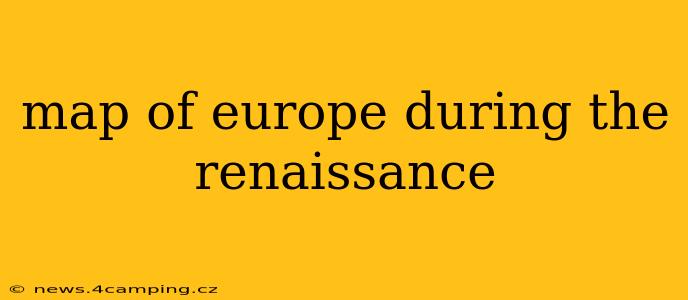The Renaissance, spanning roughly from the 14th to the 17th centuries, was a period of immense transformation in Europe. This era witnessed a flourishing of art, literature, and science, profoundly impacting the political and social landscape. Understanding the map of Europe during this time requires looking beyond static borders and acknowledging the dynamic shifts in power, alliances, and cultural influence. It wasn't a single, unified map, but rather a constantly evolving picture reflecting a complex tapestry of nations and their interactions.
What were the major political entities in Europe during the Renaissance?
Europe during the Renaissance wasn't neatly divided into the nations we recognize today. Instead, a patchwork of kingdoms, duchies, republics, and empires held sway. Major players included:
- The Holy Roman Empire: A vast, decentralized entity encompassing much of central Europe, the Holy Roman Empire was a complex web of autonomous principalities and free cities, often locked in internal power struggles. Its authority was frequently challenged by powerful regional rulers and evolving national identities.
- France: Undergoing a process of centralization under powerful monarchs like Louis XI and Francis I, France steadily consolidated its power, expanding its influence and engaging in significant conflicts with its neighbors.
- Spain: The unification of Aragon and Castile under Ferdinand and Isabella marked the beginning of a powerful Spanish Empire. Their patronage of the arts and exploration significantly shaped the Renaissance, particularly through their sponsorship of Christopher Columbus's voyages.
- England: The Wars of the Roses shaped the early Renaissance in England, culminating in the Tudor dynasty's ascent to power. Henry VII's reign ushered in an era of relative stability and paved the way for England's growing global influence.
- The Italian city-states: Florence, Venice, Milan, Genoa, and Rome were independent city-states, each with its own unique political structure and considerable economic and cultural influence. These city-states were often at war with each other, creating a volatile yet artistically vibrant environment.
- The Ottoman Empire: A significant presence in southeastern Europe, the Ottoman Empire's expansion continued throughout the Renaissance, impacting trade routes and exerting considerable political pressure on neighboring European powers. The fall of Constantinople in 1453 marked a pivotal moment, significantly altering the geopolitical landscape.
How did the map of Europe change during the Renaissance?
The map of Europe during the Renaissance was not static. Several significant shifts occurred:
- The rise of nation-states: The Renaissance witnessed the slow but steady emergence of nation-states, characterized by centralized authority, a shared culture, and defined territories. This process was particularly evident in France and Spain.
- Expansion of maritime empires: The age of exploration significantly expanded European influence globally. Portugal and Spain led the way, establishing vast overseas empires and altering trade routes and economic power dynamics in Europe.
- Religious conflicts: The Protestant Reformation, sparked by Martin Luther's Ninety-Five Theses, profoundly impacted the religious and political landscape of Europe. The ensuing religious wars led to redrawing of borders and significant shifts in power.
- Shifting alliances: Alliances between European powers were fluid and often formed and broken based on strategic interests and dynastic marriages. This led to a constantly changing geopolitical map.
How did the Renaissance impact cartography?
The Renaissance also saw advancements in cartography. Improved navigational techniques, spurred by exploration and trade, led to more accurate and detailed maps. The development of printing also contributed to the wider dissemination of geographical knowledge.
What were the major trade routes during the Renaissance?
Trade played a vital role in shaping the Renaissance. Major trade routes included:
- Mediterranean Sea: A crucial artery of commerce, connecting Europe to the Middle East and North Africa.
- Atlantic Ocean: The age of exploration opened up new trade routes across the Atlantic, connecting Europe to the Americas and transforming global commerce.
- Northern European trade routes: These routes connected various cities and regions across northern Europe, facilitating the exchange of goods and ideas.
Understanding the map of Europe during the Renaissance requires recognizing its fluidity and complexity. It was a time of immense change, where shifting political alliances, exploration, and religious conflicts reshaped the continent and laid the groundwork for the modern world. While a single, static map can't fully capture this dynamism, studying the major players and their interactions provides a valuable framework for comprehending this pivotal era.
